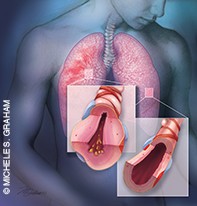Peer Reviewed
Feature Article Respiratory medicine
Asthma control in 2011. Optimising asthma treatment in adults. Part 1
Abstract
The aim of the management of patients with asthma is to optimise their asthma control. The assessment of patients’ asthma symptoms and their lung function and addressing comorbidities (such as rhinosinusitis, sleep apnoea and obesity) and risk factors (such as allergen exposure and exercise) are discussed in the first part of this two-part article.
Key Points
- Asthma control – the extent to which the effects of the disease are reduced or removed by treatment – encompasses the concepts of current control and future risk.
- The emphasis on asthma control in clinical management differs from the earlier emphasis on asthma severity, which was defined in terms of clinical features before treatment.
- Asthma that is well controlled is characterised by infrequent daytime symptoms, no activity limitation, no nocturnal symptoms and normal lung function.
- When assessing asthma control, it is important to consider both patient symptoms and lung function measurement, as well as addressing comorbidities (such as rhinosinusitis, sleep apnoea and obesity) and risk factors (such as allergen exposure and exercise).
Purchase the PDF version of this article
Already a subscriber? Login here.

